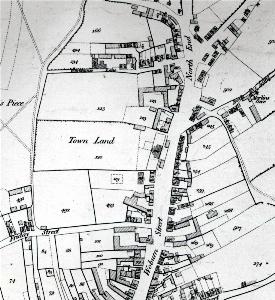The Bell and Chequer Inn Leighton Buzzard

North Street in 1819
The Bell and Chequer Inn: North Street, Leighton Buzzard
The Manor of Leighton Buzzard alias Grovebury was the principal landowner in the town before the 19th century. Bedfordshire & Luton Archives & Records Service has a full run of court rolls from 1393 to 1727 [KK619-715] and another full run from 1704 to 1867 [X288/1-23]. The service also has court rolls for other manor to own land in the town, the Prebendal Manor, from 1448 to 1459, 1588 to 1591, 1611 to 1622, 1627 and 1631 [KK792-798]. Detailed study of these would be bound to produce quite full histories for most licensed premises in the town. Unfortunately such study would take a very long time. Thus the histories of licensed premises in these web pages are quite summary and not necessarily the full story.
Maureen Brown, June Masters and Tom Lawson wrote a book called The Old Pubs of Leighton Buzzard and Linslade which was published by Leighton Linslade Local History Research Group in 1994. In producing the book they used sources at Bedfordshire & Luton Archives & Records Service, Buckinghamshire Record Office, Northamptonshire Record Office as well as a number of published sources.
The Bell and Chequer stood somewhere in North Street. It is first mentioned in 1707 when it was sold by Mary Smith, widow to Thomas Johnson of Leighton Buzzard, dealer. The inn was occupied by Joan Smith, widow [X288/1]. Two years later Johnson mortgaged the inn to Thomas Smith of Newport Pagnell [Buckinghamshire] [X288/1]. By 1745 the inn had closed as in that year a cottage noted as formerly called the Bell and Chequer was sold by William and Mary Eaton to John Eavestaff [X288/5].
This inn may, or may not, have been the Chequer, mentioned in a deposition involving sheep stealing in 1679. Names of licensed premises are very elusive things to trace. It was not unknown for two establishments with the same name to trade at the same time in the same parish, for example, and names of public houses frequently switched premises when one closed (as with the Black Lion in Leighton Buzzard High Street). Without a description of the location and ownership of the Chequer one cannot link it too firmly with an inn with a different name thirty years later.
References:
- X288/1: surrender of the Bell and Chequer: 1707;
- X288/1: conditional surrender: 1709;
- X288/5: surrender of the former Bell and Chequer: 1745;
- X288/5: admission of John Eavestaffe: 1746
List of Licensees: note that this is not a complete list; entries in italics refer to licensees where either beginning or end, or both, dates are not known:
1709: Joan Smith